Nginx开发第三方模块实例
Ø 序言
Nginx是一个极��h��展性的服务�?/span>,�q�显著体现在对第三方模块的支持,开发者能够将自己开发的模块�Q�按�?/span>nginx既有的规则,完美地融合进http框架中,以实现开发者定制功能的作用�?/span>
�q�篇文章主要用于�l�合如何开发一个简单的�W�三�Ҏ(gu��)��块,目标人群为想了解nginx开发第三方模块的同学,文章内容主要包括三个部分�Q�如何将HTTP模块嵌入nginx和如何开发第三方模块以及一个例子�?/span>
Ø 如何��?/span>HTTP模块嵌入nginx
Nginx目前来说提供了二�U�方�?/span>,config文�g+configure 脚本�Q�手动方式,后面手动方式是更加复杂的�Q�且�Ҏ(gu��)��出错�Q�在常规�?/span>nginx开发中�Q�基本上都是�?/span>config文�g+configure脚本方式比较多。接下来分别介绍�q�两�U�方式�?/span>
1) Config文�g+configure脚本
l Config文�g
�q�个是指提供config文�g�Q��ƈ且在文�g里面�l�出三个配置��,���可以达到效果。这三个配置��Ҏ(gu��)��指:
A. Ngx_addon_name�Q?/span>���是自己要开发的�q�个模块名字�?/span>
B. Nginx模块名:�q�有点像讄���环境变量啥的�Q�首先要知道自己开发啥模块�Q?/span>nginx对应的模块有�Q?/span>$HTTP_MODULES(常规�?/span>http模块), $HTTP_FILTER_MODULES(HTTP�q���o模块)�Q?/span>$HTTP_HEAD_FILTER_MODULES(HTTP 头部�q���o模块)�Q?/span> $CORE_MODULES(nginx的核心模�?/span>)�Q?/span>$EVENT_MODULES(nginx的事件模�?/span>)�{�,然后在后面添加你所要添加的模块名字�Q�以�I�格隔开�Q�比如这�ơ我们开发添加的模块:
HTTP_MODULES = “$HTTP_MODULES ngx_http_helloworld_module”
C. NGX_ADDON_SRCS�Q?/span>�q�个���思义�Q�就是指定新��d��文�g的�\径,不过�q�个都是相对路径�Q�因为在configure的时候就指定了上层�\径,比如--add-modules=PATH�?/span>
比如我们�q�次开发要��d��的源文�g�Q?/span>
NGX_ADDON_SRCS = “$NGX_ADDON_SRCS $ngx_addon_dir/ngx_http_helloworld_module.c”
l Configure脚本
�q�里需要用- -add-module=PATH���第三方模块的�\径加入,
比如configure - -add-module=~/ngx_3rd_modules/
那我们能分析下这背后做了什么呢�Q�我们从下面两个部分来展开说明
a) Auto/modules
�q�个主要是说明将定制的第三方模块��d��到生成的ngx_modules.c里面�?/span>
a) 指定模块下面的配�|�文�?/span>.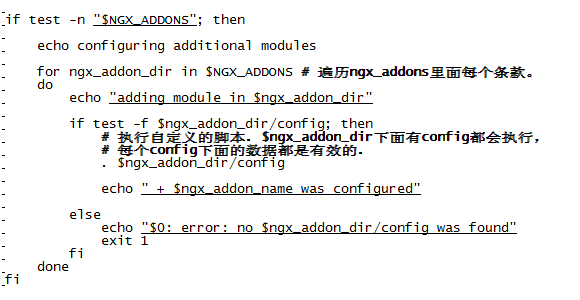
b) 生成模块信息
一�?/span>生成模块数组
�Ҏ(gu��)��需要开启的模块加蝲对应的模�?/span>,下面是开�?/span>http模块后的所需要的模块
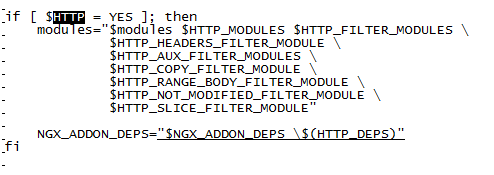
二�?/span>生成ngx_modules.c文�g
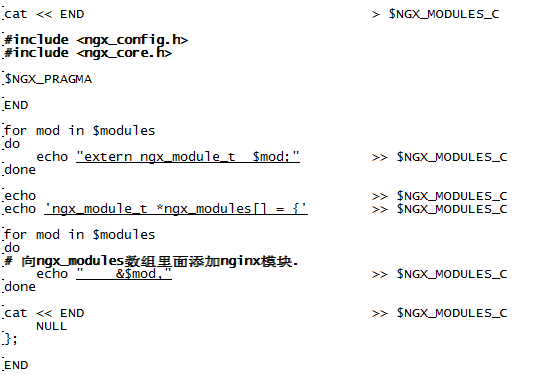
b) Auto/make
显而易见,�q�个���是负责�~�译相关的模块�?/span>
1) 生成�W�三�Ҏ(gu��)���?br />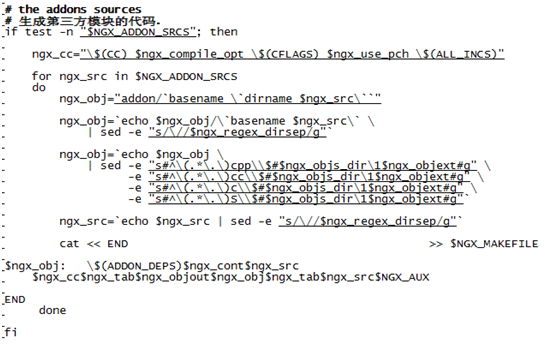
2) 生成链接代码�Q��ƈ���目标文�Ӟ��库文仉���接成二进制程�?br />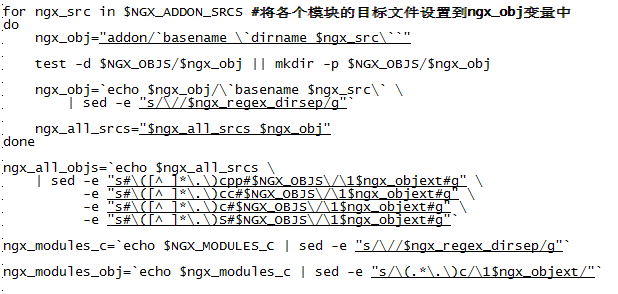

2) 手动方式
分两步来做,�W�一�Q�修�?/span>obj/ngx_modules.c, 在里面增加对应的�W�三�Ҏ(gu��)��块,�W�二�Q�修�?/span>obj/Makefile,在里面增加第三方模块的编译,�q�种直接修改的方法不太可取,易出错,一般都是用上面的第二种�Ҏ(gu��)���?/span>
Ø 开发第三方模块注意事项
首先,要确定针寚w��个模块进行开发,nginx的模块是有顺序性的�Q�比如: HTTP_MODULES = “$HTTP_MODULES ngx_http_helloworld_module”
其次�Q�因�?/span>nginx是异步非��d��的,在编制代码时�Q�一定要注意不能��d��nginx�q�程.
Ø �C�Z��
见附�?a href="/Files/jolleydtan/test.zip">/Files/jolleydtan/test.zip
参考:
深入理解nginx.
]]>
133 {
134 int size = vec.size();
135 IntVec::iterator first = vec.begin();
136 IntVec::iterator last = vec.end();
137 for(IntVec::iterator i = first + 1; i != last; ++i)
138 {
139 std::iter_swap(i, first + rand()%((i - first)+ 1));
140 }
141 return vec;
142 }
�q�个呢,不会影响源数�l�,�q�个
2�Q�取M�ơ,每次做个事情���是随机��Z��个数�Q�添加到目标数组里面�Q�然后从源数�l�中删除。�?font color="#000000" face="Verdana">
143
144 IntVec shuffle(IntVec& vec, int count)
145 {
146 IntVec desVec;
147 for(int i = 0; i < count;i++)
148 {
149 int random = rand()%vec.size();
150 desVec.push_back(vec[random]);
151 vec.erase(remove(vec.begin(),vec.end(),vec[random]),vec.end());
152 }
153 return desVec;
154 }
�q�个呢,会媄响源数组�?br />3�Q�取M�ơ,借助一个辅助数�l�记录哪个数据被取过�Q�随机出一个数�Q�添加到目标数组里面�Q�然后将�q�个值添加到辅助数组里面.
IntVec shuffle2(IntVec& vec, int count)
158 {
159 IntVec desVec;
160 IntVec flagVec;
161 for(int j = 0; j < count; j++)
162 {
163 flagVec.push_back(0);
164 }
165 for(int i = 0; i < count;i++)
166 {
167
168 int random = rand()%vec.size();
169 if (flagVec[random] == 0)
170 {
171 desVec.push_back(vec[random]);
172 flagVec[random] = 1;
173 }
174 else
175 {
176 i--;// 如果已经取过了,�q�次不算.
177 }
178
179 }
180 return desVec;
181 }
]]>
以及nginx_stream_lua模块�?br />https://github.com/openresty/stream-lua-nginx-module
本来���想着用这两个的,后来发现已经有支持了�Q�就先来试试看看�q�个了�?br />默认的话�Q�nginx是没有开启对tcp的支持的.如果要支持的话,需要用--with-stream��L��定�?br />我这边只要需要三个IP�Q�一个是nginx�q�程所在的机器�Q�我�q�边�?92.168.1.4表示�Q?br />另外两台���是TCP上游业务服务器,我们分别�?92.168.1.5�?92.168.1.21来表�C�,
��Z���q�样的考虑是因为nginx充当tcp代理服务器后�Q�自�w�也会占用一个端口�?br />�q�且从目前来��_��貌似一个nginx�q�程也就只能listen一个端口�?br />我用的版本是nginx 1.9.9.
我在/usr/local/nginx/conf下面新徏了nginx_stream_tcp.conf作�ؓ本次的测试�?br />worker_processes auto;
2 error_log /usr/local/nginx/logs/error.log info;
3 events {
4 worker_connections 1024;
5 }
6
7 stream {
8 upstream loadbalance {
9 # Specifies a load balancing method for a server group where client-server mapping is based on the hashed key value
10 hash $remote_addr consistent;
11 # sets the weight of the server, by default, 1.
12 server 192.168.1.21:8001 weight=5;
13 # by default, the parameter is set to 10 seconds.
14 server 192.168.1.5:9001 max_fails=3 fail_timeout=30s;
15
16
17 }
18
19 server {
20 # listen 8001.
21 listen 8001;
22 # Defines a timeout for establishing a connection with a proxied server.
23 proxy_connect_timeout 1s;
24 # Sets the timeout between two successive read or write operations on client or proxied server connections
25 proxy_timeout 3s;
26 # Sets the address of a proxied server
27 proxy_pass loadbalance;
28 }
29
30 }
�q�个大部分是官网支持的,所以其实我也没有修改太多,���p���|�了几个IP和端口�?br />在编译好nginx后,可以�?usr/local/nginx/sbin/nginx -c /usr/local/nginx/conf/nginx_stream_tcp.conf
���可以�v来了�Q�可以通过netstat -tlnp查看是否��h���Q�大致显�C������L���Q?br />tcp 0 0 0.0.0.0:8001 0.0.0.0:* LISTEN 7744/nginx_stream_t
当然也可以通过telnet来查看�?br />接下来,写个���单的cs�E�序来验证下�?
server端:
if __name__ == '__main__':
import socket
import commands
sock = socket.socket(socket.AF_INET, socket.SOCK_STREAM)
sock.bind(('192.168.1.21', 8001))
sock.listen(5)
while True:
connection,address = sock.accept()
print "connected by",address
while 1:
buf = connection.recv(1024)
if buf != "" :
print "connection buffer", buf
connection.sendall(buf)
connection.close()
if __name__ == '__main__':
import socket
HOST='192.168.1.4'
PORT=8001
sock = socket.socket(socket.AF_INET, socket.SOCK_STREAM)
sock.connect((HOST, PORT))
while 1:
cmd = raw_input("please input cmd:")
sock.sendall(cmd)
data = sock.recv(1024)
print data
sock.close()
在client�?92.168.1.4发�v一个TCP�q�接�Ӟ��接下�?92.168.1.4会连接到192.168.1.21�Q?br />
后面的端口应该是随机的��时端口�?br />其实它的����v��C��转发作用�Q�这个nginx�q�程相当于一个通用�|�关�Q�如果有两个client向nginx�q�程发�v�q�接�Q�一旦nginx那边调度到同一个上游TCP服务器,那么只需要从NGINX�q�程建立一个TCP�q�接��C��游TCP服务器即可�?br />之前我自��p��计网关的时候,不是依赖于用��L���Q�而是通过静态配�|�来建立�q�接的,比如上游逻辑服务器跟�|�关有连接,那都是在启动服务器的时候,���徏立�v来了�?br />�q�样有个好处���是可以省事�Q�不�q�也可以采用�q�种方式�Q�有玩家�q�接�q�某个上游TCP服务器才让网兌����q�个TCP服务器徏立连接,否则无需处理。因��Z�����时候还是会有不���服务器处于�I�闲�?
]]>
{
int a;// 装备
int b;// 角色数据
char c;
};
void main( void )
{
//printf("hello world!");
char buffer[] = "This is a test of the memset function";
A aStruct;
// 发现数据相同�?br /> memset(&aStruct,'*',sizeof(aStruct));
printf( "Before: %s\n", buffer );
memset( buffer, '*', 4 );
printf( "After: %s\n", buffer );
if (buffer[2] == '*')
{
printf("hello,world\n");
}
// 判断�q�个是否要保存�?br /> if (aStruct.a == 0x2a2a2a2a)
{
// 发送给DBSERVER.
printf("hello char\n");
}
if (aStruct.c == 0x2a)
{
}
getchar();
]]>
Direct3D9: (INFO) :MemFini!
Direct3D9: (WARN) :Memory still allocated! Alloc count = 152
Direct3D9: (WARN) :Current Process (pid) = 00000fb8
Direct3D9: (WARN) :Memory Address: 00c95988 lAllocID=1 dwSize=000047f8, (pid=00000fb8)
�q�里是检���出内存泄露�?
一般是内存信息什么的没有releasing和deleting�?
之前遇到的一个问题lock is not supported when multi-sampling is enabled是因为shader debugging打开了,之后关闭了,���没有事情了�?br>刚才�~�译hlsl的时候,发现了x3025错误�Q�后来的dx版本要��用D3DXSHADER_ENABLE_BACKWARDS_COMPATIABLITY|D3DXSHADER_DEBUG才能�~�译,特别�?008�q�的dx版本�?br>
DX默认的是D3DFILL_SOLID�Q�如果出现D3DFILL_WIREFRAME的情况一定要讄���回去�?
CD3DArcBall:允许你将用户的输入解释�ؓ旋�{或者��^�U?我们所要做的是���鼠标消息传递给�q�个�c?�q�且���视囄���阵设为类的旋转或者��^�Uȝ��阵就可以�?
点乘: a.b = ||a|| *||b|| * cosA, 一般用来判断�ؓ0,那么表明正交,>0,方向基本相同,<0,方向基本相反.使用点乘来计���投�?
�l�定两向量v,n,���其分解为v�q�_��v�?分别�q����于和垂直于n,�q�且满�� v = v�q?v�?一般成�q����分量v�q��ؓv在n 上的投媄.
V�q?= n * ||V�q�|| / ||n||.
cosA = ||V�q�||/||V|| cosA||V|| = ||V�q�||
V�q? n*n*v/( ||n||*||n||).
叉乘得到的向量垂直于原来的两个向�?
a *b指向该��^面的正上�?垂直于a和b.
||a*b|| = ||a|| * ||b|| * sinA.
||a*b|| 也等于以a和b��Z��边的�q����四边形的面积.
如果a,b�q����或�Q意一个�ؓ0,则a*b = 0,叉乘寚w��向量的解释是它��^行于��L��其他向量,点乘的解释是和�Q意其他向量垂�?
��L��对角矩阵D,都有D转置矩阵= D,包括单位矩阵.
DirectX使用的行向量.
v = xp+yq+zr,向量v���p���C�成p,q,r的线性变换了,向量p,q,r�U�做基向�?�q�里基向量是�W�卡���坐标系
变换物体相当于以相反的量变换描述�q�个物体的坐标系.
2d里面是这栯����|�的:
逆时针旋转经�?不是必须)被认为是正方�?��时针方向是负方�?
�l�x轴旋�?
[ 1 0 0
0 cosA sinA
0 -sinA cosA]
�l�y轴旋�?
[cosA 0 -sinA
0 1 0
sinA 0 cosA]
�l�z轴旋�?
[ cosA sinA 0
-sinA cosA 0
0 0 1]
�l���un旋�{角度A,那么获得的矩阉|��:
[nx*nx*(1-cosA)+cosA nx*ny*(1-cosA)-nz * sinA nx*nz*(1-cosA) + ny*sinA
nx * ny *(1-cosA) - nz *sinA ny*ny*(1-cosA)+cosA ny*nz*(1-cosA) - nx* sinA
nx * nz *(1-cosA)+ny * sinA ny * nz *(1-cosA) + nx* sinA nz*nz*(1-cosA)+cosA]
�~�放:通过基向量构造矩�?得到以单位向量n为羃放方�?k为因子的�~�放矩阵:
s(n,k) = [ p] [ 1 + (k-1)nx2 (k-1)nxny (k-1)nxnz]
=
[ q] [ (k -1)nxny 1+(k-1)ny2 (k-1)nxnz]
[ r] [(k-1)nxnz (k-1)nzny 1+(k-1)nz2]
投媄意味着降维操作,有一�U�投影方法是在某个方向上用零做羃攑֛��?�q�种情况�?所有点都被拉��^臛_��直的�?2D)或��^�?3D),�q�种�c�d��的投��q��做正交投�?或者��^行投�?因�ؓ从原来的点到投媄点的直线�怺��q����.
n垂直于投��q���U?而不是��^�?3D�?向垂直于n的��^面投��q��矩阵如公�?
p(N) = [1-nx2 -nxny -nxnz]
[-nxny 1-ny2 -nynz]
[-nxnz -nzny 1-nz2]
镜像: ���物体沿直线(2D�?或��^�?3D�?���L��.
P(n) = [ 1-2nx2 -2nxny -2nxnz]
[-2nxny 1-2ny2 -2nynz]
[-2nxnz -2nzny 1-2nz2]
Hxy的意义是x,y坐标被坐标z改变
Hxy(s,t) = [1 0 0]
[0 1 0]
[s t 1 ]
Hxz(s,t) = [ 1 0 0]
[s 1 t]
[0 0 1]
Hyz(s,t) = [1 s t]
[0 1 0]
[0 0 1]
M物体->像机 = M物体->世界M世界->像机
P->像机 = P物体 M物体->像机
�U��Ş变换: 如果满��下式,那么映射f(a)���是�U�性的:
f(a+b) = f(a) + f(b)
以及F(ka) = kf(a).
仿射变换: �U�性变换后接着�q�移,因此仿射变换的集合是�U�性变换的���集.��M���U�性变换都是仿���变�?但不是所有仿���变换都是线性变�?
如果存在一个逆变换可�?撤消"原变�?那么该变换是可逆的.
如果变换前后两向量夹角的大小和方向都不改�?该变换是�{�角.只有�q�移,旋�{和均匀�~�放是等角变�?
�{�角变换���会保持比例不变.
�q�移,旋�{和镜像是仅有的正交变�?长度,角度,面积,和体�U�都保持不变.
刚体变换只改变物体的位置和方�?不包括�Ş�?所有长�?角度,面积和体�U�都不变.�q�移和旋转是仅有的刚体变�?镜像�q�不被认为是刚体变换.
假设矩阵M有r�?c�?记法Mij表示从M中除�ȝ��i行和�W�j列后剩下的矩�?昄���,该矩阉|��r-1�?c-1�?矩阵Mij�U�CؓM的余子式.
]]>
graphics adapter contains the hardware needed store and display images on a monitor or other display device.
all of these adapters stored a representation of the displayed image in a bank of dual-ported memeory called a frame buffer.
the system uses one of the ports to read and write images into the frame buffer.the second port is used by the video scan out circuitry of the adapter to create a signal for the monitor.Direct3D only supports VGA compatible adapters.
Frame Color Lookup
Buffer Table
2D Pixel D/A
Engine Converter
Host CPU CRT Monitor
Direct3D abstractions include :device, swap chains, surfaces, and resource .
an application enumerates the devices available on each adapter, examining their capablities and supported display modes to find an acceptable device.
device is the object that expose the rendering operations of the hardware. its properties control the rendering behavior or provide information about rendering, while the device's methods are used to perform the rendering itself.
devices always contain at least one swap chain and a collection of resources used for rendering.
resources are application specific data stored in or near the device hardware for use during rendering Direct3D provides resources for scene geometry(vertices and indices) and appearance(images, textures, and volumes).
a surface is a resource containing a rectangular collection of pixel data such as color, alpha, depth/stencil or texture information.
a swap chain contains one or more back buffer surfaces where scenes are rendered and presented for display on the monitor, is a collection of back buffers.
a device's render target is the back buffer surface, with an optional depth/stencil surface, in which rendering will occur.
while all back buffers are valid render targets, not all render targets are back buffers.
it is also possible to have a texture as a render target allowing dynamic rendering effects.
to obtain a device object, Direct3D provides an object for device enumeration and creation. all other objects are created through the device. an application first obtains the runtime interface, then selects and creates a device from those available, and using the device creates the necessary resources for rendering.
most COM methods return HRESULT to indicate success or failure.
in windowed mode: the results of graphic rendering are presented for display insidei the client area of a window on the desktop.
Direct3D cooperates with GDI to make the results of rendering visible, using a ::StretchBlt operation to present a back buffer in the window's client region
in exclusive mode: Direct3D communicates directly with the display driver avoiding GDI. when an exclusive mode application is running, no other applications have access to display hardware and no GDI is visible on the screen.
HAL(hardware abstraction layer): has hardware acceleration of graphics rendering, making it fastest device type.
reference device: useful for debugging, when developing software applications that target new features not yet common in hardware, the reference device maybe your obly choice for generating an image with those Direct3D features.
the null reference device: does nothing and all rendering will result in a black screen.useful for manipulating resources on a machine that provides no hardware or software implementation of the runtime.
the pluggable software device: RegisterSoftwareDevice method,
each resource has Type, Pool, Format, and Usage attributes, each of these attributes of a resource are specified at the time the resource is created and remain constant for the lifetime of the resource object.
type attributes describes the kind of resource and is defined by D3DRESOURCETYPE.
pool attribute of a resource describes how it is managed by the Direct3D runtime and is defined by the D3DPOOL enumeration.
resources in the default pool exist only in device memory.
resources in the managed pool exist in system memory and will be copied into the device's memory by the runtime when needed.
resource in the system memory pool exist only in system memory
resource in the scratch pool reside only in system memory and are not bound by format constraints of the device
when a device is lost, all resources in the default pool are lost and should be released and recreated by the application when the device is regained.
Format attribute of a resource describes the layout of the resources's data in memory and is defined by the D3DFORMAT enumeration.
all resources have a format, but most of the format enumerants define the memory layout for pixel data.
D3DFMT_D24S8: D:depth buffer, S:stencil buffer.
Usage attribute describes how the application will be use the resource and is defined by a collection of flag bits. static reources are typically loaded with data once and used repeatedly without change, while dynamic resources are repeatedly modified bu the application.
a direct3D application starts by obtaining the IDirect3D9 COM interface pointer by calling Direct3DCreate9.
GetAdapterCount is to determine the number of adapters in the system. each adapter provides a number of video display modes. each display mode contains a screen dimention, refresh rate and pixel format and is described by D3DDISPLAYMODE structure.
the back buffer surface format of a device must be compatible with the display mode's format. CheckDeviceFormat method can be used to discover compatible formats.
GetAdapterModeCount: the number of display modes.
EnumAdapterModes: the display mode information.
GetAdapterDisplayMode: the display mode currently in use by the adapter.
two display modes can have the same width, height and format values but different values for the RefreshRates.
the CheckDeviceType method tells us if a particular combination of display format and back buffer format are valid for a device of a given type operating in windowed or exclusive mode.
with a valid device type, we can check the device's capabilities for rendering required by our application with GetDeviceCaps.
we can validate all the resources required by our application with the CheckDeviceFormat, checkDeviceFormat should be used to validate all the format of all resources used by the application: back buffer surfaces, depth/stencil surfaces, texture surfaces, and volume texture formats. if the application requires a depth buffer for viaiblitiy determination, it should use CheckDepthStencilMatch to find a depth buffer that can be used with its render target formats in a given display mode.
CheckDeviceMultiSampleType: check multisampling needs.
GetAdapterIdentifier: allows an application to identify a specific brand of adapter from a specific vendor.
D3DCREATE_ADAPTERGROUP_DEVICE: allows an application to drive both video outputs through a single device interface, allowing resources to be shaed for both outputs.
Direct3D uses single precision floating point computations. if an application requires higher precision from FPU.there are two choices, either the application can ensure that the FPU is in single precision mode when calling into Direct3D, or ir can request that the device preserve the application's FPU precision before Direct3D performs any floating -point operations and restore the precision before returning to the application.
D3DCREATE_SOFTWARE_VERTEXPROCESSING: select software vertex processing, which is always available from the runtime.the runtime used an efficient implementation of software vertex processing that is optimized for the CPU.
D3DCREATE_MIXED_VEVERTEXPROCESSING: select a combination of software and hardware vertex processing selected by SetSoftwareVertexProcessing mixed vertex processing is incompatible with a pure device and will fail if both are requested together.
D3DPRESENTFLAG_DEVICECLIP: restricts the results of a present operation to the client area of the device window in windowed mode.
D3DPRESENTFLAG_DISCARDDEPTHSTENCIL: instructs the runtime to discard the contents of the depth stencil surface after a call to Present, or when a new depth stencil surface is set on the device.
D3DPRESENTFLAG_LOCKABLEBACKBUFFER: requests a default swap chain with back buffer surfaces that can be directly accessed by the application.
in windowed mode: hDeviceWindow specifies the window whose client area will be used for presentation in windowed operation if hDeviceWindow is zero, then the focus window willbe used for presentation.
in exclusive mode, hDeviceWindow specifies the top-level window used by the application
D3DPRESENT_RATE_DEFAULT: instructs the runtime to choose a suitable refresh rate in exclusive mode, and uses the current refresh rate in windowed mode.
an application may wish to create a full-screen display on a specific monitor.
GetAdapterMonitor: return an HMONITOR handle for an adapter, once you have the handle to the device 's montior, u can determine what part of the virtual desktop is covered by the monitor.
each object in a scene is described by a collection of geometric primitives, such as points, lines, and triangles, with the device's action methods.
the pipeline converts geometric descriptions into pixels on the render target surface through the process of rasterization. graphic primitives are rendered in the order in which they are described to the devices similar to the way a CPU executes binary instructions sequentially through memory.
the entire graphics pipeline is controlled through the properties of the device.
the properites are manipulated through the Get/Set methods of the device.
every device has a distinct set of capabilities. Direct3D specifies an abstract machine interface, but does not provide a software emulation for a feature not provided directly by the hardware's driver.
a device provides specific information on its capabilities to allow an application to adapt to the capabilities of the device.
much of the behavior of the graphics pipeline is controlled by render states.
groups of device properties, including render states, can be cached and set as a group with state blocks.
the device object represents the rendering pipeline, we get images from the pipeline by supplying it with scene data and instructing it to render scenes into images.
scene data consists of geometric data defining shapes in space and data defining the appearance of the shapes.
we can break the pipeline up into large sections consisting of vertex data assembly, vertex processing, promitive assembly and rasterization, pixel processing, the frame buffer,a dn video scan out.
vertex data assembly section gathers together vertex components from a collection of data streams to assemble a compute vertex and its associated data.
vertex processing performs computations on each vertex such as the transformation and lighting of vertices.the processed vertex data is then assembled into graphic primitives and rasterized into a stream of pixels.
pixel processing performs a computations on each rasterized pixel to determine the final color of the pixel that will be written into the frame buffer.
frame buffer performs a read/modify/write operations combining processed pixels from the rasterizer with the existing pixels in the render ttarget.
video scan out reads the pixels out of the frame buffer for conversion into video signals displayed by the monitor.
scenes are rendered to the render target selected on the device. if the render target is part of a swap chain, the render target can be made viaible on the device through presentation.
the render target may not be part of a swap chain if the render target is a texture resource.
you present renderings for display through a swap chain as the last thing you do when rendering a scene.
a swap chain consists of one or more back color buffers into which images are rendered. a device is always associated with at least one swap chain and in windowed mode additional swap chains can be created to obtain multiple presentable surfaces.
the philosophy of the Direct3D object is to expose the capabilities of the hardware to the application programmer and let the application adapt to the hardware.
GetDeviceCaps: return the capabilities of an actual device, while GetDeviceCaps method on the Direct3D object returns the generic capabilities of a device.
IUnknown
IDirect3DVolume9
IDirect3DResource9
IDirect3DIndexBuffer9
IDirect3DVertexBuffer9
IDirect3DSurface9
IDirect3DBaseTexture9
IDirect3DTexture9
IDirect3DCubeTexture9
IDirect3DVolumeTexture9
resource objects are used as containers for the scene data rendered by the device such as primitive vertices, indices intto vertex arrays, surface textures and volumes.
two and three dimensional textures expose their contents as collections of sutfaces and volumes, respectively. the back buffer, depth/stencil buffer and render target properties of the device are also exposed as surfaces.
volume objects do not inherit from IDirect3DResoutce9 and therefore do not participate in the resource management exposed by this interface.
managed resources are assigned an unsigned integer priority, with higher priority taking precedence so that resources with a lower priority are discarded from device memory first.
non-managed resources always return a priority of zero. within the same priority, Direct3D uses a least-recently used strategy to discard old resoucrs in preference to newly created resources.
when the application attempts to use more resources than the card can hold while rendering a scene, Direct3D switches to a most-recently used first strategy for discarding memory.
resources in D3DPOOL_DEFAULT are not managed and are never discarded from device memory by the resource manager.
if u need to allocate new resources in the default pool after managed resources have been loaded, you should evict all managed resources before allocating new resources in the default pool.
resources in pool D3DPOOL_SYSTEMMEM are never located in device memory, so that they do not participate in resource management.
GetAvailableTextureMem: obtain an estimate of the available texture memory.
the GetDevice method returns the device with which this resource is associated. resources cannot be shared across devices.
GetPrivateData/SetPrivateData: allow an application to associate its own arbitrary chunks of data with any Direct3D erouces.
each distinct item of private data is identified by a GUID. all private data associated with a resource is freed when the associated resource itself is freed.
methods and functions in Direct3D that create COM objects, such as CreateDevice, add a reference to the object for the caller before they return the interface pointer, the application must release these objects when they are no longer needed to avoid a memory leak.
Device queries allow you to obtain information from the driver layer of the device, the two main uses for driver queries are for obtaining rendering statistics and event notifications from the device.
D3DQUERYTYPE enumeration gives the possible kinds of queries: vertex cache description queries, resource manager statistics queries, vertex statistics queries, event queries, occlusion queries, timestamp queries, time queries and cache utilization queries.
a query exists in one of three state: signaled, building, or issued.
Issue: used by the application to signal a state transition on the query.
the device driver can also change the state of a query when it has returned the data requested by the query.
the query will report the results for primitives issued between the begining of the query and the end of the query.
occlusion queries return the number of pixels that passed the depth test for primitives rendered between the begin and end of the query.
the resource manager statistics query returns a D3DDEVINFO_RESOURCEMANAGER structure, which contains an array of D3DRESOURCESTATS structure, one for each resource type.
the vertex cache is a memory cache close to the GPU that avoids access to vertex memory for a small number of recently used vertices.
PIX: is a performance measurement tool for DirectX applications. the remaining query types return data for performance measurements with tools like PIX.
the device object's properties control the behavior of the rendering pipeline while its methods supply data for the pipeline to render.
state blocks are COM objects that provide a way for your application to cache a group of device properties for later use.
each state block is associated with a device, returned by the GetDevice method.once a state block has been created, the state block can be applied to the device by calling apply on the state block, calling capture on an existing state block captures the current values of the device properties into the state block.
there are two ways to create a state block object and fill it with specific device property values.
the first way: call CreateStateBlock with D3DSTATEBLOCKTYPE value identifying the kind of state you want recorded in the block.
the second way of obtaining a state block object is to call BeginStateBlock, set device properties and then call EndStateBlock.
when EndStateBlock is called, each device property marked for capture is recorded into the state block. if a device property is set multiple times between BeginStateBlock and EndStateBlock, only the last value set in the property is captureed into the state block.
release the state block COM object when you are finished with a state block.
a pure device has a performance advantage because the runtime and driver do not have to keep a copy of the non-queryable state for the application.
scenes contain one or more objects that are positioned relative to each other and to the virtual camera that views the scene. such objects are called "models", and contain data that define their shape and apperance. the shape of a model is described by a collection of a simple geometric shapes, called graphic primitives.
when we draw a three dimensional scene, we need to solve the problem of visibility: objects in the foreground should occlude objects in the background. Two- dimensional applications use a painter's algorithm to determine visibility. Direct3D can use depth/stencil surfaces to resolve visibility.
using either a flexible vertex format or a vertex shader declaration, Direct3D describes colors, textures corrdinates,vertex blending weights and arbitrary shader data at each vertex.the vertex data is supplied to the device through a collection of streams, each associated with a vertex buffer.
the streams can be driven through a level of indirection with an index buffer.the streams can be driven though a level of indirection with an index buffer.
the scene is described to the device one primitive at a time. each primitive is rasterized into a collection of pixels written to the render target property of the device.
All Direct3D rendering is done within a scene. each successive frame draws the models at successive moments in time, as in cel animation used for cartoons.
frame rates of greater than 15 fps can be preceived as "real-time", the z-buffer algorithm solution to the visibility problem works at each pixels on the render target instead of on models, as models are rasterized, each pixel that is associated with z value is used to determine which pixel is cloest to the camera.the closer pixels are stored into the render target, while pixels farther away are discarded. the depth/stencil buffer holds each pixel's depth from the camera. to use the Z-buffer for resolving visibility, set RS_Z Enable to D3DZB_TRUE, RS_Z Write Enable to TRUE, and RS_Z Func to D3DCMP_LESS.
if the D3DPRASTERCAPS_ZBUFFERLESSHSR bit of D3DCAPS9:RasterCaps is set, it indicates the device has an alternative visivility algorithm for hidden surface removal that doesn't use a Z-buffer. how visibility is determined is hardware dependent and application transparent.
all back buffers on swap chains are valid render targets, but render targets are not restricted to back buffer surfaces, when the device is created or reset, the render target is back buffer zero of the device's default swap chain. when present is called on the device, the render target advances to the next back buffer so that after present returns, render target is back buffer zero again.
setting the render target to a surface other than a back buffer surface allows the device to render directly into an imanage surface instead of rendering into a swap chain's back buffer and using stretchrect to obtain the results of the rendering, which could stall the pipeline.
D3DPT_POINTLIST draws a collection of points,
D3DPT_LINELIST draws a squence of possibly disjoint line segments.
]]>
static bool ChangeChannelAndSetFocus(char* username,Channel channel);
�q�段代码看�v来是没有事情�?但是在接口设�|�上面存在不好的做法,如果是私密频道的�?是有用username做私聊对象的,如果是非�U�聊频道的话,���没有这个私聊对象了.但是如果要调用这个接口的�?�q�得�l�个�q�样的�?
比如�q�样的用�?->ChangeChannelAndSetFocus("",public_channel),
其实如果�E�微改变一下接口设�|�的�?���好�?
static bool ChangeChannelAndSetFocus(Channel channelchar* username = "");
�q�样使用默认参数���好�?
之前的调用就可以�q�样使用�?
:->ChangeChannelAndSetFocus(public_channel),看�v来舒服多�?哎感觉编�E�功底还有待加强,�q�么���单的问题,拿出来想�?�q�有�q�么多学问呢.
�q�几天写了一�D�函��C���?后来被一个家伙调用了,他直接在我的函数里面修改,�q�样造成了原来我函数里面的逻辑出现错误,现在��x��,如果以后是这��L��情况,��׃��能允�总�在我的函数里面修�Ҏ(gu��)��的逻辑和相兌����?但是要留出接口给它调�?至于具体的操�?要我自己允许才能��d��,当然我可以帮他看看原来他��d��的代�?但是�q�样也就没有什么意义了.�q�种合作性的工作���其要讲�I�这�?不然很麻烦的.
�H�然惌��v来要记录点什�?调试引擎的时�?可以采用�q�样的方�?打开上层逻辑的工�E?然后���引擎相关的代码拖拽��C��层逻辑所在的工程里面�?然后在这个代码里面可以设�|�相��x���?以前��M��知道怎么找上层逻辑与底层引擎的入口,最�q�终于知道了.呵呵.通过�q�样的方�?���可以在上层逻辑做某些操�?然后兌����q�些逻辑相关的引擎代�?
今天一直在被单态困扰着,事情是这��L��:大厅和战斗场景里面都有两个类似的chatroom,�q�且他们各自使用的协议是不一��L��.现在��x��他合�q��v来做成类似singleton的东�? 之前���遇��C��个问题,大厅和战斗场景不能在�怺�之间发送信息,后来我的处理�Ҏ(gu��)��是将战斗场景里面��d��大厅里面的响应事�Ӟ���q�样的话�Q�在大厅里面发送私聊信息到战斗场景里面�Q�就可以接受��C���Q�但是后来发现在战斗场景里面发送信息到大厅里面�Q�却接受不到�Q��ƈ且这个时候,在大厅和战斗场景里面已经存在很多冗余代码了,�q�样的处理让我感觉很不爽�Q�我在想有没有其它办法,后来��h��了老大�Q�老大帮忙解释了一下,后来�Q�在协议处理方式上面修改了一下,才可以的。chatroom在不同的时候发送不同的协议���好了,�q�且在接受的时候分开大厅和战斗场景处理就好了�Q�这栯���是用了接受、和发送这两段废代码。对于singleton的了解还是不够好�?nbsp;
之前遇到的问题,是聊天发送消息�ƈ不立��x���C�在本地�Q�而要先将信息转到服务端,服务端进行查询,如果能够扑ֈ��q�个�U�聊对象�Q�那么就�q�回�l�信息,否则���显�C����该用户不存在�Q�在战斗场景里面向大厅的某个玩家发送私聊信息以后,退出战斗场景以后,发现大厅里面�q�显�C�着在战斗场景里面发送的聊天信息。这样即使我按照常规思�\��L���|�络接受端的相关代码注释掉也不能辑ֈ�消除大厅里面的聊天信息的目的�Q�感觉很郁闷。后来查看私聊信息方面的代码�Q�发现没有将信息有效地拦截,�U�聊信息在本��C��面还可以被显�C�,没有�l�过�|�络斚w��的验证就直接发送过来了。在�U�聊信息斚w��做一些处理�ƈ且在退出战斗场景的时候做一些信息删除处理,�q�样���可以达到目的了�?
因�ؓ玩家对象位置数据是从服务器那边发送过来的,玩家从服务器获得数据需要一�D�|���?所以需要加入一个插�?来将现在的位�|�过渡到下一个的位置.�q�里可以采用多种插值方�?
今天写了代码��L��写强制动作的处理�Q�结果发现很多处是有问题的,其中原因是没有将原来的代码作用看仔细造成了,感到���愧呢,
另外在编写交互性比较强的代码时�Q�一定要考虑自己的代码可能带来的影响�?br>
更新某个文�g比较�ȝ��的话,那么可以先采用原始文件删�?�q�且重新全部更新的做法去�?而不是用更新某个字段的方法去�?
如果没有初始化声韌���备成功的�?那么应该可以弹出提示信息�?�q�且���原始声音音量设�|��ؓ0.
之前在修改一个bug(在�h物控刉���板打开以后,一直克隆object,造成了在引擎底层无法锁定vertexBuffer的问�?,开始以为是内存泄露�?在打开控制面板10分钟以后,游戏���q��然出错了,�q�一度想用一些辅助工��h��查找内存的信息是否出�?后来发现在�h物控刉���杉K��面克隆了�q�多的�h物object,而这些object却没有及时地删除,造成占用�q�多的资�?到最后连锁住vertex buffer也不行了.在分析这个问题上面的时�?我还是一个劲地挖底层而没有考虑太多的逻辑层面的东�?实在有点南辕北辙的味�?值得反省.
在输入的使用上面,一般的游戏都采用directInput,即��是U2,上次遇到的问题是,在一同事机器上面�q�行输入的时候就�q�入不了,但是在别人的机器上面却可以运行好好的,后来�l�常查访发现:1)用配�|�文件写入的,之后再绑定到某个特定键的快捷键都不能�?因�ؓ�q�些是读入内存以�?然后用add_binding来绑定到directInput讑֤�上面�?2) 在游戏里面��用windows message的却可以正常使用.�q�入游戏的时�?你不能输�?而只能回�?按tab键以�?���可以在登陆界面输入,如果不能按tab�?则不能输�?�q�入游戏以后却可以按不是从配�|�文仉���面读取的信息,比如技�?人物面板,仓库,以及地图�{?
其中我个人徏议是,���量不要用directInput.1)首先是directInput依赖于机�?如果机器好的�?那么没事�?如果有事情的�?那么也很难解�?2)directInput里面采用了hook,来拦截消�?�q�样,�q�不如直接用windows message来的�?
http://www.gamedev.net/community/forums/topic.asp?topic_id=520366
详细的讨�����上面.
在调试逻辑没有发现什么错误提�C�的时�?试着去调试引�?可能问题发生得更加深,不在逻辑层面�?而在引擎内部,�q�样���p��直接调试引擎�?
在涉及到渲染斚w��的bug,���量借用d3ddebugging来辅助查�?�q�样可以方便解决问题.
�q�接错误�Q�IID_IDirectSound3DBuffer�Q�其实加上dxguid.lib���好了�?br>�U�理��d��模式包括�Q?br>wrap, border color, clamp,和mirror以及mirror once.
pDrawPrimInternal->SetTexture(hTex);
之前遇到的一个问题是�Q�显�C�玩家在���地图上面到地图边界了,�q�能重复�l�制地图�Q�给人的感觉好像是走不到边界�Q�走地图好像是在卯��u里面一栗��?br>后来才知道一般默认的�U�理��d��模式是wrap方式�?br> get_device()->SetSamplerState(0,D3DSAMP_BORDERCOLOR,0x00ffffff);
get_device()->SetSamplerState(0, D3DSAMP_ADDRESSU, D3DTADDRESS_BORDER);
get_device()->SetSamplerState(0, D3DSAMP_ADDRESSV, D3DTADDRESS_BORDER);
解决bug有时候不如重�?br>���量让策划去���理逻辑�Q�逻辑�E�序员尽量将重心攑֜�具体技术问题上面,不懂的地方应该主动跟�{�划沟通,而不是自己想�?br>代码可以先模拟出来,然后再放到具体的环境里面���试�Q�独立写个demo之后再去���试�Q�这样往往会比较快捷和省事情�?br>学会模拟机器执行代码的次序,�q�且提高阅读代码的问题,之前的时候,我��劲去调试�Q�每�ơ调试只��Z��解决一个问题,但是事实上,如果从阅��M��码开始的话,那么我可以省�?天的旉����?br>学会调节�~�写代码时候的心情和心态,�q�样有助于进行高效编�E�,当心情不好的时候,一定要集中全部的注意力�Q��ƈ且将思�\和流�E�作出图记蝲在纸上面�Q�这样可以强�q�自己全���诏注�?br>
今天遇到的文件打开问题是文件名路径有空格造成的,值得指出的是对于文�g打开报错�Q�一般很难获得返回��g��息,但是可以通过GetLastError或者@Err,以及hr�{�来获得一些错误返回��g��息�?br>
对字�W�串操作�Q�尽量要���查是否有�I�格�Q�如果字�W�串长度前面有空格的话,那么���被认�ؓ所提供的字�W�串是空的。要避免�q�种情况的发生。对于字�W�串匚w��要注意部分匹配的情况�Q�比�?Tex", "Text",�q�里如果只匹配前面三个字�W�的话,那么两者是相等的,之前���遇��C��个这��L��问题�Q�就是texture的信息被text信息所覆盖了,��D��控�g找不到正���的texture而不能显�C�出来�?nbsp;
今天遇到的问题是�q�样的,之前遇到的状态切换问题,是与状态切换无养I��而与插值有养I��在切换状态以后,收到一个插��g���|�,�q�样又给角色一个新的位�|�,�l�别人看的效果就是角色先落地了,之后又上升了�Q�像坐电梯一栗���不�q�从�q�里说明了一个问�?我在思考问题的时候,有欠周全的因素�?br>
今天跟踪一个bug,在战斗的时候,出现卡死的情况,后来发现状态切换出��C��问题�Q�后来一直去查看战斗斚w��的状态,但是�q�没有发��C��么结果,现在在想在战斗中的标志或者状态的时候应该设立一些标志集合,�q�样便于在某个时候检查一些状态的信息。现在很多的标志在游戏里面,局部的�Q�全局的,标志在角色上面的�Q�标志在物体上面的,�q�些都需要好好地���理�?br>
全方�?多角度地思考问�?而不能将思维局限在某处.学会从大局或者小处去分析问题,大处不行的话,���小�?���相关的信息串�v�?所有的信息应该是个串型或者链型的.之前在处理问题的时�?把思�\限制在太���的范围内了.以至于花了很多时间才扑ֈ�问题所�?
�Ҏ(gu��)��正常情况和非正常情况来获得数据比较,以确定正���的���程和结构。如果遇到错误的乱��|��那么���q��看正常的数��|��然后�Ҏ(gu��)���q�个比较来获得一些提�C�Z��息�?br>
今天犯了错误�Q�自己有最新版本,但是没有上传�Q�结果vss上面的版本把自己的最新版本给覆盖了�?br>
在发送消息的时候,有时候�ؓ了防止频�J�发送消息,要加入一个cd旉����Q�防止因为网�l�问题,服务端收到玩家连�l�的信息�?br>
物理�pȝ��, v = v0 - gt. 玩家上蟩的速度表示,而在下降,则是v = gt,按照自由落体�q�动来进�?�q�且速度是个向量,�q�样如果在X,Z轴上面有初速度的话,那么���可能出现抛物线的情�?
]]>